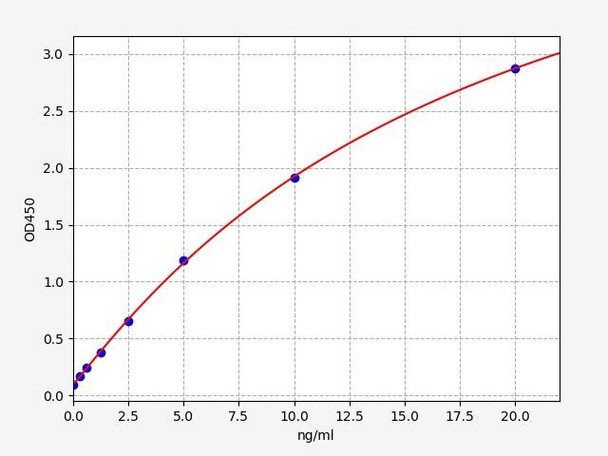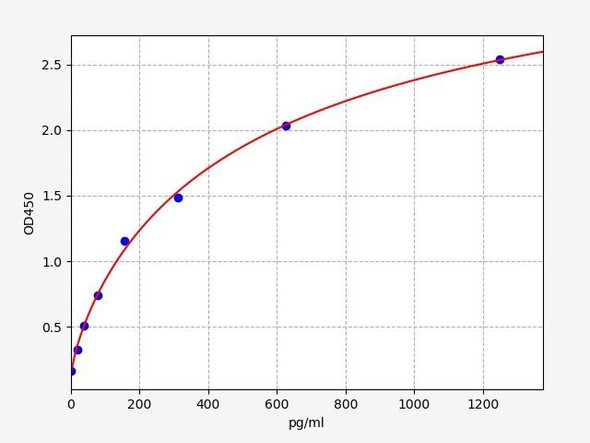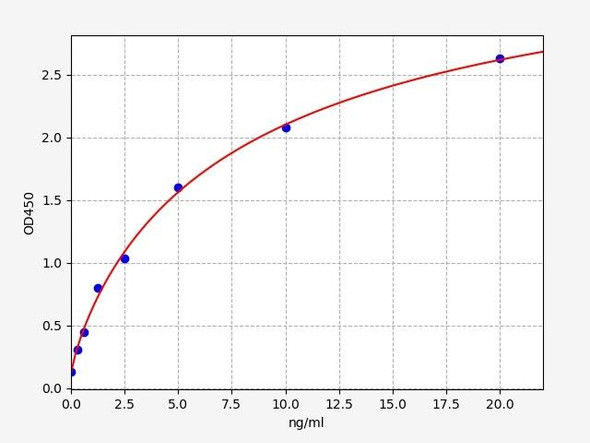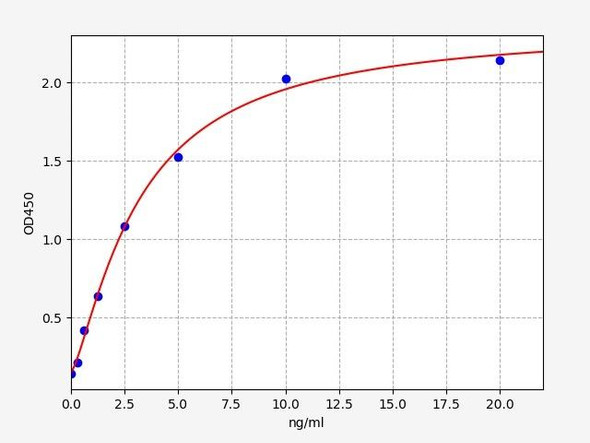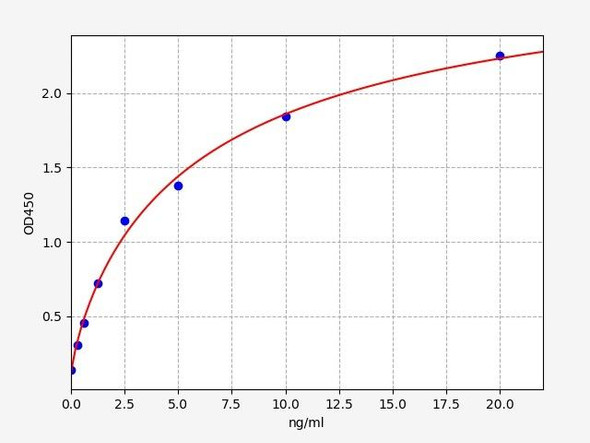Human Connexin 26 / GJB2 ELISA Kit
- SKU:
- HUFI02369
- Product Type:
- ELISA Kit
- Size:
- 96 Assays
- Uniprot:
- P29033
- Sensitivity:
- 0.188ng/ml
- Range:
- 0.313-20ng/ml
- ELISA Type:
- Sandwich ELISA, Double Antibody
- Synonyms:
- CX26, Connexin 26, GJB2, Connexin-26, DFNB1, DFNA3A, Gap junction beta 2 protein
- Reactivity:
- Human
Description
| Product Name: | Human Connexin 26 / GJB2 ELISA Kit |
| Product Code: | HUFI02369 |
| Size: | 96 Assays |
| Alias: | CX26, Connexin 26, GJB2, Connexin-26, DFNB1, DFNA3A, Gap junction beta 2 protein |
| Detection method: | Sandwich ELISA, Double Antibody |
| Application: | This immunoassay kit allows for the in vitro quantitative determination of Human CX26 concentrations in serum plasma and other biological fluids. |
| Sensitivity: | 0.188ng/ml |
| Range: | 0.313-20ng/ml |
| Storage: | 4°C for 6 months |
| Note: | For Research Use Only |
| Recovery: | Matrices listed below were spiked with certain level of Human CX26 and the recovery rates were calculated by comparing the measured value to the expected amount of Human CX26 in samples. | ||||||||||||||||
| |||||||||||||||||
| Linearity: | The linearity of the kit was assayed by testing samples spiked with appropriate concentration of Human CX26 and their serial dilutions. The results were demonstrated by the percentage of calculated concentration to the expected. | ||||||||||||||||
| |||||||||||||||||
| CV(%): | Intra-Assay: CV<8% Inter-Assay: CV<10% |
| Component | Quantity | Storage |
| ELISA Microplate (Dismountable) | 8×12 strips | 4°C for 6 months |
| Lyophilized Standard | 2 | 4°C/-20°C |
| Sample/Standard Dilution Buffer | 20ml | 4°C |
| Biotin-labeled Antibody(Concentrated) | 120ul | 4°C (Protect from light) |
| Antibody Dilution Buffer | 10ml | 4°C |
| HRP-Streptavidin Conjugate(SABC) | 120ul | 4°C (Protect from light) |
| SABC Dilution Buffer | 10ml | 4°C |
| TMB Substrate | 10ml | 4°C (Protect from light) |
| Stop Solution | 10ml | 4°C |
| Wash Buffer(25X) | 30ml | 4°C |
| Plate Sealer | 5 | - |
Other materials and equipment required:
- Microplate reader with 450 nm wavelength filter
- Multichannel Pipette, Pipette, microcentrifuge tubes and disposable pipette tips
- Incubator
- Deionized or distilled water
- Absorbent paper
- Buffer resevoir
| Uniprot | P29033 |
| UniProt Protein Function: | GJB2: One gap junction consists of a cluster of closely packed pairs of transmembrane channels, the connexons, through which materials of low MW diffuse from one cell to a neighboring cell. Defects in GJB2 are the cause of deafness autosomal recessive type 1A (DFNB1A). DFNB1A is a form of sensorineural hearing loss. Sensorineural deafness results from damage to the neural receptors of the inner ear, the nerve pathways to the brain, or the area of the brain that receives sound information. Defects in GJB2 are the cause of deafness autosomal dominant type 3A (DFNA3A). Defects in GJB2 are a cause of Vohwinkel syndrome (VS). VS is an autosomal dominant disease characterized by hyperkeratosis, constriction on finger and toes and congenital deafness. Defects in GJB2 are a cause of palmoplantar keratoderma with deafness (PPKDFN). PPKDFN is an autosomal dominant disorder characterized by the association of palmoplantar hyperkeratosis with progressive, bilateral, high-frequency, sensorineural deafness. Defects in GJB2 are a cause of keratitis-ichthyosis- deafness syndrome (KID syndrome); an autosomal dominant form of ectodermal dysplasia. Ectodermal dysplasias (EDs) constitute a heterogeneous group of developmental disorders affecting tissues of ectodermal origin. EDs are characterized by abnormal development of two or more ectodermal structures such as hair, teeth, nails and sweat glands, with or without any additional clinical sign. Each combination of clinical features represents a different type of ectodermal dysplasia. KID syndrome is characterized by the association of hyperkeratotic skin lesions with vascularizing keratitis and profound sensorineural hearing loss. Clinical features include deafness, ichthyosis, photobia, absent or decreased eyebrows, sparse or absent scalp hair, decreased sweating and dysplastic finger and toenails. Defects in GJB2 are the cause of Bart-Pumphrey syndrome (BPS). BPS is an autosomal dominant disorder characterized by sensorineural hearing loss, palmoplantar keratoderma, knuckle pads, and leukonychia, It shows considerable phenotypic variability. Defects in GJB2 are the cause of ichthyosis hystrix-like with deafness syndrome (HID syndrome). HID syndrome is an autosomal-dominant inherited keratinizing disorder characterized by sensorineural deafness and spiky hyperkeratosis affecting the entire skin. HID syndrome is considered to differ from the similar KID syndrome in the extent and time of occurrence of skin symptoms and the severity of the associated keratitis. Belongs to the connexin family. Beta-type (group I) subfamily. |
| UniProt Protein Details: | Protein type:Motility/polarity/chemotaxis; Membrane protein, multi-pass; Cell adhesion; Membrane protein, integral Chromosomal Location of Human Ortholog: 13q11-q12 Cellular Component: connexon complex; ER-Golgi intermediate compartment; integral to membrane; plasma membrane; lateral plasma membrane Molecular Function:gap junction channel activity Biological Process: sensory perception of sound; gap junction assembly; cell-cell signaling; transport; male genitalia development; decidualization; response to progesterone stimulus; transmembrane transport; response to estradiol stimulus Disease: Deafness, Autosomal Recessive 1a; Ichthyosis, Hystrix-like, With Deafness; Deafness, X-linked 2; Deafness, Congenital, With Keratopachydermia And Constrictions Of Fingers And Toes; Keratitis-ichthyosis-deafness Syndrome, Autosomal Dominant; Knuckle Pads, Leukonychia, And Sensorineural Deafness; Keratoderma, Palmoplantar, With Deafness; Deafness, Autosomal Dominant 3a |
| NCBI Summary: | This gene encodes a member of the gap junction protein family. The gap junctions were first characterized by electron microscopy as regionally specialized structures on plasma membranes of contacting adherent cells. These structures were shown to consist of cell-to-cell channels that facilitate the transfer of ions and small molecules between cells. The gap junction proteins, also known as connexins, purified from fractions of enriched gap junctions from different tissues differ. According to sequence similarities at the nucleotide and amino acid levels, the gap junction proteins are divided into two categories, alpha and beta. Mutations in this gene are responsible for as much as 50% of pre-lingual, recessive deafness. [provided by RefSeq, Oct 2008] |
| UniProt Code: | P29033 |
| NCBI GenInfo Identifier: | 77416855 |
| NCBI Gene ID: | 2706 |
| NCBI Accession: | P29033.3 |
| UniProt Secondary Accession: | P29033,Q508A5, Q508A6, Q5YLL0, Q5YLL1, Q5YLL4, Q6IPV5 Q86U88, Q96AK0, Q9H536, Q9NNY4, |
| UniProt Related Accession: | P29033 |
| Molecular Weight: | 26,215 Da |
| NCBI Full Name: | Gap junction beta-2 protein |
| NCBI Synonym Full Names: | gap junction protein, beta 2, 26kDa |
| NCBI Official Symbol: | GJB2 |
| NCBI Official Synonym Symbols: | HID; KID; PPK; CX26; DFNA3; DFNB1; NSRD1; DFNA3A; DFNB1A |
| NCBI Protein Information: | gap junction beta-2 protein; connexin 26; gap junction protein beta 2 |
| UniProt Protein Name: | Gap junction beta-2 protein |
| UniProt Synonym Protein Names: | Connexin-26; Cx26 |
| Protein Family: | Gap junction beta-2 protein |
| UniProt Gene Name: | GJB2 |
| UniProt Entry Name: | CXB2_HUMAN |
*Note: Protocols are specific to each batch/lot. For the correct instructions please follow the protocol included in your kit.
Before adding to wells, equilibrate the SABC working solution and TMB substrate for at least 30 min at 37°C. When diluting samples and reagents, they must be mixed completely and evenly. It is recommended to plot a standard curve for each test.
| Step | Protocol |
| 1. | Set standard, test sample and control (zero) wells on the pre-coated plate respectively, and then, record their positions. It is recommended to measure each standard and sample in duplicate. Wash plate 2 times before adding standard, sample and control (zero) wells! |
| 2. | Aliquot 0.1ml standard solutions into the standard wells. |
| 3. | Add 0.1 ml of Sample / Standard dilution buffer into the control (zero) well. |
| 4. | Add 0.1 ml of properly diluted sample ( Human serum, plasma, tissue homogenates and other biological fluids.) into test sample wells. |
| 5. | Seal the plate with a cover and incubate at 37 °C for 90 min. |
| 6. | Remove the cover and discard the plate content, clap the plate on the absorbent filter papers or other absorbent material. Do NOT let the wells completely dry at any time. Wash plate X2. |
| 7. | Add 0.1 ml of Biotin- detection antibody working solution into the above wells (standard, test sample & zero wells). Add the solution at the bottom of each well without touching the side wall. |
| 8. | Seal the plate with a cover and incubate at 37°C for 60 min. |
| 9. | Remove the cover, and wash plate 3 times with Wash buffer. Let wash buffer rest in wells for 1 min between each wash. |
| 10. | Add 0.1 ml of SABC working solution into each well, cover the plate and incubate at 37°C for 30 min. |
| 11. | Remove the cover and wash plate 5 times with Wash buffer, and each time let the wash buffer stay in the wells for 1-2 min. |
| 12. | Add 90 µl of TMB substrate into each well, cover the plate and incubate at 37°C in dark within 10-20 min. (Note: This incubation time is for reference use only, the optimal time should be determined by end user.) And the shades of blue can be seen in the first 3-4 wells (with most concentrated standard solutions), the other wells show no obvious color. |
| 13. | Add 50 µl of Stop solution into each well and mix thoroughly. The color changes into yellow immediately. |
| 14. | Read the O.D. absorbance at 450 nm in a microplate reader immediately after adding the stop solution. |
When carrying out an ELISA assay it is important to prepare your samples in order to achieve the best possible results. Below we have a list of procedures for the preparation of samples for different sample types.
| Sample Type | Protocol |
| Serum | If using serum separator tubes, allow samples to clot for 30 minutes at room temperature. Centrifuge for 10 minutes at 1,000x g. Collect the serum fraction and assay promptly or aliquot and store the samples at -80°C. Avoid multiple freeze-thaw cycles. If serum separator tubes are not being used, allow samples to clot overnight at 2-8°C. Centrifuge for 10 minutes at 1,000x g. Remove serum and assay promptly or aliquot and store the samples at -80°C. Avoid multiple freeze-thaw cycles. |
| Plasma | Collect plasma using EDTA or heparin as an anticoagulant. Centrifuge samples at 4°C for 15 mins at 1000 × g within 30 mins of collection. Collect the plasma fraction and assay promptly or aliquot and store the samples at -80°C. Avoid multiple freeze-thaw cycles. Note: Over haemolysed samples are not suitable for use with this kit. |
| Urine & Cerebrospinal Fluid | Collect the urine (mid-stream) in a sterile container, centrifuge for 20 mins at 2000-3000 rpm. Remove supernatant and assay immediately. If any precipitation is detected, repeat the centrifugation step. A similar protocol can be used for cerebrospinal fluid. |
| Cell culture supernatant | Collect the cell culture media by pipette, followed by centrifugation at 4°C for 20 mins at 1500 rpm. Collect the clear supernatant and assay immediately. |
| Cell lysates | Solubilize cells in lysis buffer and allow to sit on ice for 30 minutes. Centrifuge tubes at 14,000 x g for 5 minutes to remove insoluble material. Aliquot the supernatant into a new tube and discard the remaining whole cell extract. Quantify total protein concentration using a total protein assay. Assay immediately or aliquot and store at ≤ -20 °C. |
| Tissue homogenates | The preparation of tissue homogenates will vary depending upon tissue type. Rinse tissue with 1X PBS to remove excess blood & homogenize in 20ml of 1X PBS (including protease inhibitors) and store overnight at ≤ -20°C. Two freeze-thaw cycles are required to break the cell membranes. To further disrupt the cell membranes you can sonicate the samples. Centrifuge homogenates for 5 mins at 5000xg. Remove the supernatant and assay immediately or aliquot and store at -20°C or -80°C. |
| Tissue lysates | Rinse tissue with PBS, cut into 1-2 mm pieces, and homogenize with a tissue homogenizer in PBS. Add an equal volume of RIPA buffer containing protease inhibitors and lyse tissues at room temperature for 30 minutes with gentle agitation. Centrifuge to remove debris. Quantify total protein concentration using a total protein assay. Assay immediately or aliquot and store at ≤ -20 °C. |
| Breast Milk | Collect milk samples and centrifuge at 10,000 x g for 60 min at 4°C. Aliquot the supernatant and assay. For long term use, store samples at -80°C. Minimize freeze/thaw cycles. |

